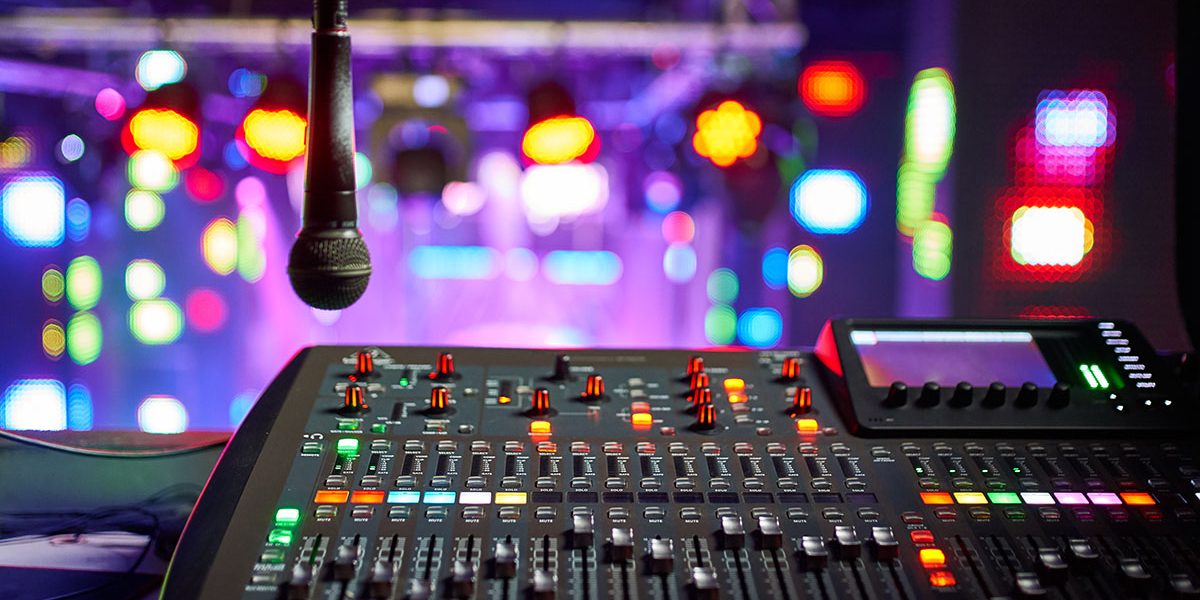Step-by-step guide on budgeting for audio visual charlotte nc
Wiki Article
Understanding the Incorporation of Audio Visual Technology in Today's Educational Environments
The assimilation of audio-visual innovation in academic setups has actually changed the training and learning process. Educators now have accessibility to tools that satisfy various discovering designs, enhancing student engagement and partnership. The consolidation of these modern technologies presents both possibilities and challenges. Recognizing exactly how to efficiently implement these devices is essential. What methods can instructors employ to maximize the advantages of audio-visual modern technology in their class?The Advancement of Audio-Visual Innovation in Education And Learning
As instructional demands advanced over the years, audio-visual modern technology undertook considerable makeovers that reshaped the knowing environment. Devices such as film projectors and slide shows were the key means of incorporating visual components right into classrooms. These very early innovations provided teachers with the ability to existing info dynamically, yet they were limited in availability and interactivity.With the arrival of video clip cassette recorders in the 1970s, classrooms started to integrate documented lessons, expanding the range of academic sources. The introduction of computers in the 1980s further changed this landscape, enabling the creation of multimedia discussions and interactive learning experiences.
The increase of the web in the 1990s noted a zero hour, making it possible for real-time accessibility to a riches of audio-visual products. Today, electronic devices such as interactive whiteboards and on-line knowing systems proceed to boost the academic experience, fostering involvement and partnership amongst learners.
Advantages of Audio-Visual Tools for Diverse Discovering Styles
Audio-visual devices play an essential role in dealing with diverse understanding designs by improving visual understanding and improving acoustic engagement. By incorporating images, video clips, and noise, these modern technologies create an even more comprehensive educational environment. This complex technique enables teachers to deal with the varied choices and requirements of pupils successfully.Enhancing Visual Understanding
Involvement in the knowing process is noticeably improved through using audio-visual devices, dealing with various discovering styles. These tools, such as video clips, infographics, and interactive presentations, provide aesthetic stimulations that assist understanding and retention. Visual students, in certain, advantage from the incorporation of pictures and computer animations, which can simplify complex concepts and boost understanding. In addition, audio-visual resources can show real-world applications, making finding out more relevant and interesting. By integrating color, activity, and sound, teachers can produce a dynamic knowing environment that records students' attention and fosters deeper cognitive links. Eventually, the critical use audio-visual technology not only sustains aesthetic discovering but also enriches the general educational experience for diverse learners.Improving Auditory Involvement
A substantial advantage of incorporating audio-visual tools in education is their capability to enhance auditory involvement amongst pupils. These devices, which incorporate multimedia discussions, podcasts, and interactive sound elements, accommodate various discovering designs, especially benefiting acoustic learners (audio visual charlotte nc). By integrating audio and narration, teachers can produce immersive experiences that catch trainees' focus and strengthen understanding. This engagement is important, as it fosters a deeper understanding of the product and promotes retention. Additionally, audio-visual devices can assist in joint discovering settings, urging pupils to participate in discussions and share their understandings. Ultimately, the consolidation of audio-visual technology not only supports auditory interaction yet additionally enriches the overall educational experience, making finding out more vibrant and reliable for all studentsEnhancing Interaction Via Interactive Learning

In addition, gamification aspects, such as tests and simulations, can improve motivation and retention, making discovering more pleasurable and effective. These strategies not just promote cognitive engagement but additionally provide to varied discovering styles, making sure that all trainees can get involved meaningfully. Consequently, interactive knowing atmospheres promote a feeling of neighborhood and belonging, ultimately leading to enhanced scholastic outcomes. Through the integration of audio visual innovation, educators can change conventional classrooms right into vivid rooms where pupils prosper and actively shape their educational journeys.
Linking Theory and Exercise With Multimedia Resources
Multimedia sources act as a crucial link between academic concepts and useful application in educational settings. By enhancing engagement, facilitating joint understanding experiences, and supporting diverse discovering styles, these devices develop a more comprehensive and dynamic learning setting - audio visual charlotte nc. This strategy not only promotes deeper understanding yet likewise prepares students for real-world difficulties
Enhancing Involvement With Multimedia
Engagement in instructional settings substantially enhances when trainers incorporate multimedia resources into their training techniques. Using video clips, podcasts, and interactive presentations improves the discovering experience, enabling trainees to connect with the product on numerous degrees. Multimedia resources deal with numerous finding out styles, giving visual, auditory, and kinesthetic stimulations that can hold pupils' attention extra successfully than typical lecture approaches. In addition, these resources can streamline intricate ideas, making them much more easily accessible and unforgettable. By incorporating multimedia, educators can produce a vibrant class setting that cultivates inquisitiveness and inspires learners. Inevitably, the tactical usage of audio-visual innovation offers to bridge the gap between academic knowledge and sensible application, improving the academic experience for both instructors and trainees.Assisting In Collaborative Discovering Experiences
Numerous researches suggest that collective discovering experiences considerably improve trainee end results when incorporated with multimedia resources. Multimedia tools help with interaction among trainees, enabling them to involve in analytic and critical assuming collectively. By using video clip conferencing, collaborative systems, and interactive presentations, teachers create environments for synergy and shared knowing. These innovations allow pupils to connect their ideas efficiently and receive prompt feedback, fostering a much deeper understanding of the topic. On top of that, multimedia resources can provide intricate concepts in more digestible layouts, advertising discussion and partnership. Because of this, the mix of collective discovering and audio-visual technology not only improves the educational experience but additionally prepares trainees for real-world teamwork characteristics, emphasizing the significance of cooperation and collective knowledge construction.Sustaining Diverse Learning Styles
While standard teaching approaches typically accommodate a restricted series of learning preferences, the combination of audio-visual modern technology provides a much more inclusive technique to education. By using multimedia sources such as videos, interactive simulations, and digital discussions, instructors can address different learning designs, including visual, auditory, and kinesthetic. This adaptability enables set read this apart guideline, allowing pupils to involve with web content in means that reverberate with their specific preferences. In addition, audio-visual tools can facilitate much deeper understanding by offering numerous depictions of complicated concepts. Because of this, trainees that may battle with standard methods can locate alternate pathways to success, fostering a much more equitable knowing setting that sustains academic achievement for all students.Obstacles in Applying Audio-Visual Technology
Although audio-visual technology holds wonderful pledge for boosting instructional experiences, its execution usually runs into significant difficulties. One key worry is the financial burden connected with purchasing and maintaining such tools, which can stress spending plans, particularly in underfunded institutions. Additionally, inadequate training for teachers can impede effective combination, leaving them ill-prepared to use the innovation completely. Technical concerns, such as software malfunctions and compatibility issues, might additionally interfere with lessons and discourage both educators and students. Additionally, differing levels of pupil accessibility to modern technology outside the classroom can produce variations in finding out chances. Finally, the possibility for over-reliance on modern technology might take away from vital teaching methods, eventually restricting the academic experience. Resolving these difficulties needs a detailed approach, consisting of appropriate funding, specialist advancement, and fair access to resources, to assure that audio-visual modern technology can be leveraged properly in today's educational setups.Finest Practices for Integrating Innovation in the Class

In addition, fostering an interactive environment through collaborative tools motivates pupil involvement and engagement. Utilizing varied audio-visual resources accommodates different learning designs, accommodating aesthetic, auditory, and kinesthetic students. Consistently examining the influence of modern technology on pupil discovering helps educators fine-tune their techniques and adjust to transforming demands. Finally, entailing pupils in the choice of modern technology promotes ownership and motivation. By sticking to these ideal practices, educators can develop a dynamic classroom atmosphere that properly incorporates innovation and enhances the educational experience for all trainees.
The Future of Audio-Visual Modern Technology in Education And Learning
As classrooms significantly embrace innovation, the landscape of audio-visual tools in education and learning remains to progress (audio visual charlotte nc). Future improvements are anticipated to concentrate on better interactivity and personalization, permitting instructors to tailor finding out experiences to individual pupil requirements. Technologies such as increased truth (AR) and online fact (VIRTUAL REALITY) will likely provide immersive discovering atmospheres, improving trainee involvement and understanding
Synthetic knowledge (AI) is poised to play a considerable role in audio-visual technology by using real-time responses and adaptive understanding paths. This combination might help educators recognize and deal with student obstacles better. Cloud-based platforms will certainly assist in much easier accessibility to resources and partnership among pupils and instructors, no matter place.
Along with these technical advancements, specialist advancement for instructors will be important, ensuring they are geared up to utilize these tools properly. On the whole, the future of audio-visual innovation in education and learning assures to develop even more dynamic, comprehensive, and impactful discovering experiences.
Regularly Asked Questions
Just How Can Educators Pick the Right Audio-Visual Devices for Their Classrooms?
Choosing ideal audio-visual devices needs teachers to evaluate their educational objectives, consider trainee needs, examine readily available innovation, and look for suggestions from peers or specialists, ensuring tools properly boost learning and interaction within their certain class setting.What Spending plan Factors to consider Are There for Carrying Out Audio-Visual Innovation?
Spending plan considerations for implementing audio-visual technology consist of initial purchase prices, upkeep expenses, training for personnel, and prospective software program licensing costs. Furthermore, long-lasting investment in updates and replacements need to likewise be factored into financial planning.Are There Certain Training Resources for Educators on Audio-Visual Devices?
Many organizations use training resources for educators on audio-visual tools, including on-line courses, why not try here workshops, and training overviews. These sources aim to boost teachers' skills and self-confidence in effectively integrating technology into their teaching practices.How Do We Gauge the Performance of Audio-Visual Modern Technology in Learning?
Gauging the effectiveness of audio-visual innovation in discovering includes assessing student engagement, understanding, retention rates, and overall scholastic efficiency. Studies, evaluations, and empirical research studies can provide valuable understandings into its influence on educational outcomes.What Prevail False Impressions About Audio-Visual Technology in Education And Learning?
Common false impressions check it out regarding audio-visual technology in education consist of the belief that it guarantees engagement and finding out results, along with the assumption that all pupils benefit equally, neglecting private knowing choices and needs.Report this wiki page